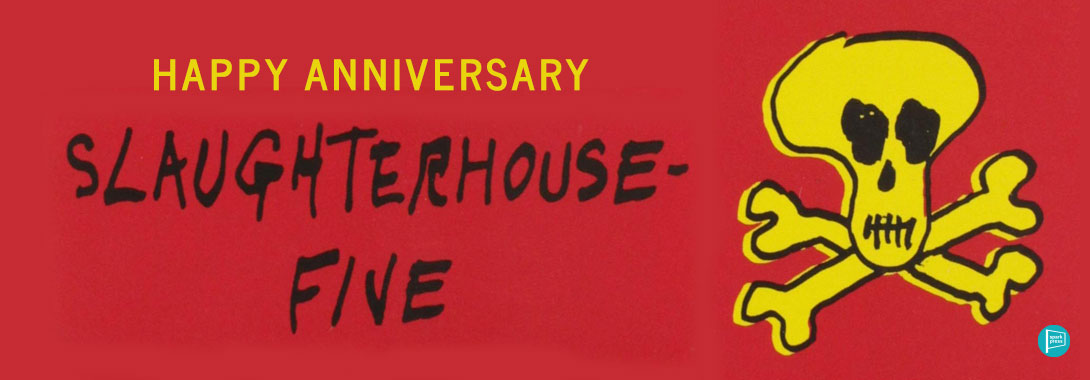
Slaughterhouse Five is one of the most banned books of all time. This iconic semi-autobiographical novel was released on March 31, 1969. To celebrate the 50thanniversary, we’ve got a list of other ingenious works that you may love, depending on what drew you to Slaughterhouse Five in the first place.
If you love an unreliable narrator, read…
Gone Girl by Gillian Flynn
When Amy disappears, all eyes are on her husband, Nick. As the story progresses, at first told by Nick and through Amy’s diary entries, the reader starts to try to piece together what happened. Is Nick lying to the police and media? Certainly. Is he lying to the reader? Unclear. Could he have really killed Amy? Or is she the unreliable narrator?
Life of Pi by Yann Martel
The Japanese authorities who interrogate Pi refuse to believe his story about coexisting on a lifeboat with a 450-pound Bengal tiger for 227 days while lost at sea. After hours of coercion, Pi tells another, more realistic story. But is the realistic story any more true than the fantastical one?
If you’re interested in depictions of the Holocaust, read…
Night by Elie Wiesel
This candid account of Elie Wiesel’s survival as a teenager in Nazi death camps is truly horrific. Beyond the sadism and never-ending terrors at both Auschwitz and Buchenwald, this poignant memoir addresses questions about what the Holocaust was, what it meant, and attempts to ensure that the world doesn’t forget man’s capacity for inhumanity.
The Zookeeper’s Wife by Diane Ackerman
This non-fiction book tells the true story of Jan and Antonina Zabinski. Jan was the zookeeper at the Warsaw Zoo during WWII. After it was bombed, he and his wife, Antonina, saved over three hundred people by hiding them in the empty animal cages. This exceptionally well-researched story will awe readers with the bravery and humanity of this couple.
If you love a good time travel story, read…
Proof of Forever by Lexa Hillyer
In this lyrical novel, a group of former best friends are transported back in time to the summer when everything changed. With the flash of a photobooth camera, Joy, Tali, Luce, and Zoe are given the chance to relive that perfect summer and the secret that could unravel everything. This summer will change the girls forever . . . again.
Stolen Time by Danielle Rollins
When Dorothy, a con artist living in Seattle in 1913, stows away in Ash’s peculiar aircraft, she has no idea that she’s about to be in way over her head. She wakes up in 2077 in a chilling version of the world she left behind. For Ash, Dorothy spells nothing but trouble. She’s the last thing he needs if he’s going to stop his terrifying visions of the world from coming true.
If you’re interested in depictions of PTSD, read…
The Impossible Knife of Memory by Laurie Halse Anderson
For the past five years, Hayley Kincaid and her father, Andy, have been nomadic. Andy can’t seem to shake the demons that have haunted him since his tour in Iraq. They’re finally putting down roots in his hometown so Hayley can go to school. But will Andy’s return help his PTSD, or push him over the edge?
Something Like Normal by Trish Doller
When Travis returns from Afghanistan, he is plagued by nightmares of his best friend’s death. On top of dealing with his PTSD issues, all is not well at home. His parents are on the outs and his brother has stolen his car and his girlfriend. It’s only when he reconnects with Harper, a girl he’s known since middle school, that he is able to start picking his way through the minefield that is his life.
If you love stories with a nonlinear timeline, read…
Sometimes I Lie by Alice Feeney
In this New York Times bestseller, Amber wakes up in a hospital. She can’t move, speak, or even open her eyes—but she can hear everything going on around her. Sometimes I Lie alternates between her paralyzed present, the weeks leading up to her “accident,” and childhood diaries, as she tries to piece together what happened.
Cloud Atlas by David Mitchell
This beloved novel begins in 1850, following a notary voyaging the seas. It abruptly jumps to Belgium 1931 to follow a disinherited bisexual composer. Then the story jumps ahead once again, this time to a troubled reporter on the West Coast in the 1970s. It jumps ahead three more times into the end of time and boomerangs back again, connecting them.

Leave A Comment